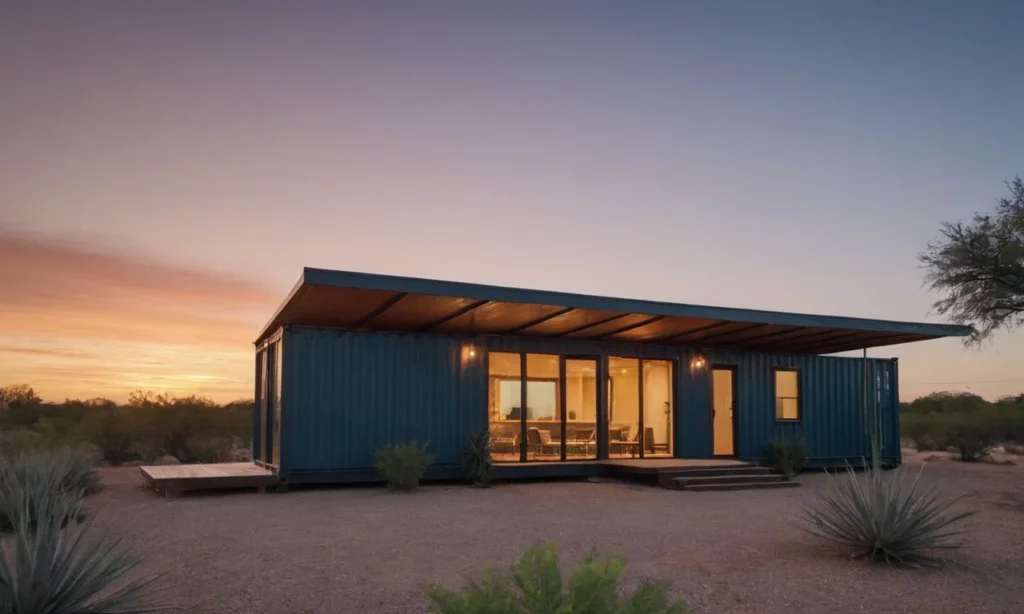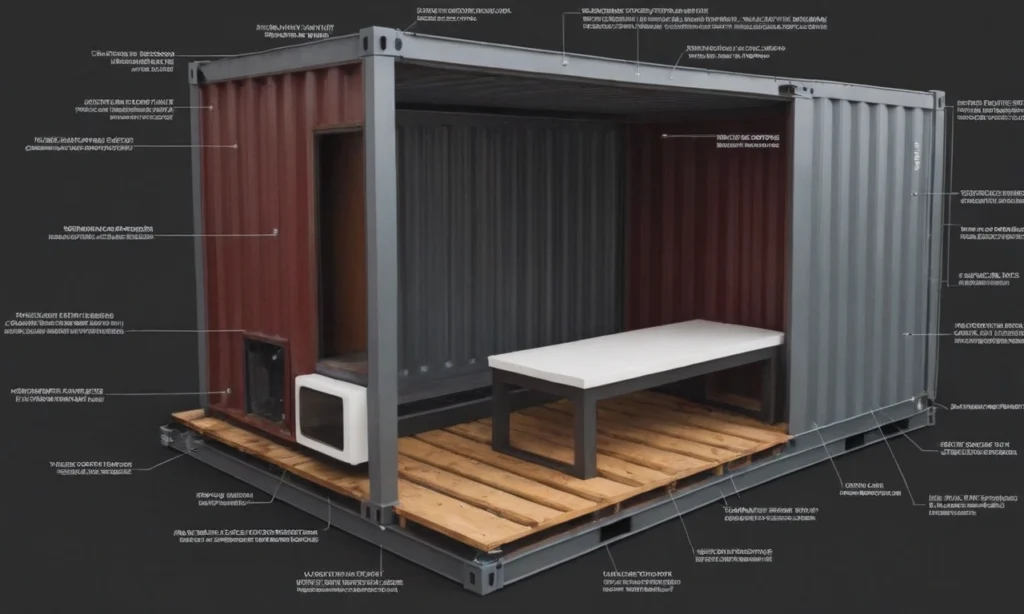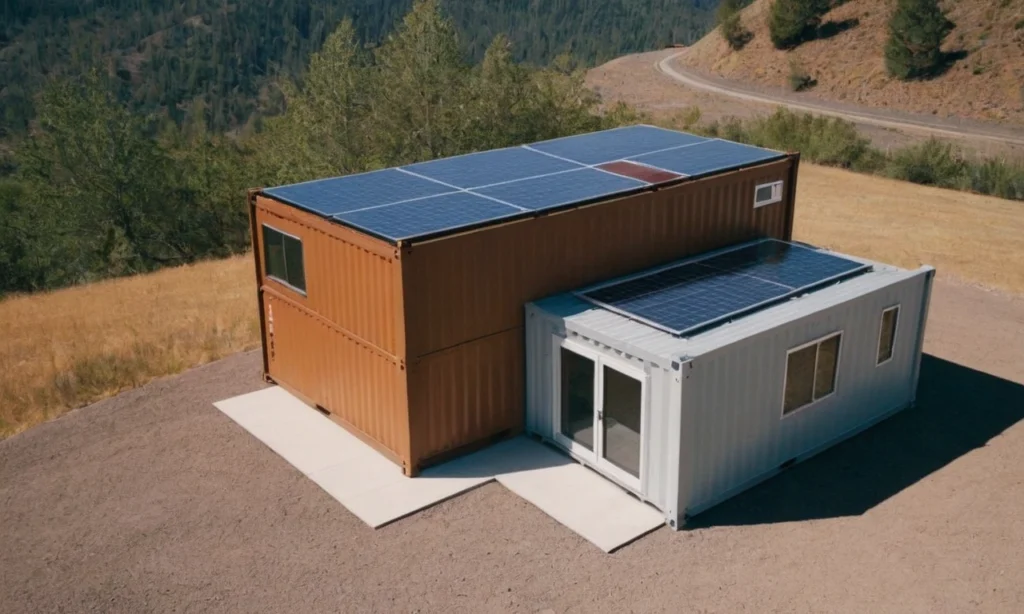Shipping container homes have emerged as an innovative and cost-effective housing solution across the United States. These sustainable dwellings, constructed from durable steel containers originally designed for transporting goods, offer a unique alternative to traditional construction methods. However, their legality varies significantly from state to state, with local zoning laws and building codes determining whether you can build your container dream home in a particular location.
What Are Shipping Container Homes?
Shipping containers are sturdy structures designed to withstand the rigors of international transport by truck, train, ship, and aircraft. Typically made of steel, wood, or corrugated aluminum, these containers have gained popularity as building materials for residential and commercial structures, including:
- Primary residences
- Vacation homes
- Office spaces
- Retail stores
- Studios
- Bars and restaurants
This alternative construction method has been embraced globally, with successful container home projects in France, Denmark, the United States, New Zealand, and England.
States That Allow Shipping Container Homes
While local regulations ultimately determine the legality of container homes in specific areas, the following states are generally considered container-home friendly:
1. Texas
Texas is known for its relatively lenient regulatory environment, including building regulations. The state has numerous shipping container homes of various sizes, making it an excellent location for container home construction. Rural and suburban areas of Texas tend to be more accepting of these structures than major cities like Houston. The state also has multiple specialized container home builders ready to help create your dream container home.

2. California
Despite California’s reputation for strict land use policies, this progressive state accepts shipping container homes provided they meet safety requirements and obtain proper permits. Many residents successfully own hybrid container homes with all necessary approvals. The most affordable locations for container homes in California are typically found inland or in northern regions, where land ordinances are less restrictive.
3. Louisiana
Louisiana ranks first in the United States for land freedom according to the Cato Institute. The state takes a liberal approach to zoning regulations with minimal governmental interference in how people build their homes. Container home owners in Louisiana enjoy the freedom to build according to their preferences, with regulatory oversight limited to basic local land measurements and references to the local land use climate.
4. Tennessee
Residents of Tennessee enjoy significant land freedom compared to other states, with minimal local interference and building regulations. This makes Tennessee an ideal location for shipping container homes. The state offers good access to clean water, reducing construction costs and creating opportunities for low-income residents to build container homes. West Tennessee offers particularly affordable options, with rural areas perfect for off-grid living and a climate featuring all four seasons.
5. Missouri
Missouri’s local zoning codes recognize shipping container homes as affordable living alternatives, and in some areas, you can build without requiring a building permit. The state’s climate, featuring warm summers and mild winters, creates an ideal environment for container homes while helping owners save on expensive insulation costs that would be necessary in harsher climates.
6. Oregon
In Oregon, shipping container homes can be built on land designated for single-family homes. While the state maintains strict builder regulations, it takes a progressive approach to alternative construction methods. Oregon is particularly suitable for those seeking off-grid living with minimal external interference.
7. Alaska
Alaska’s vast terrain and low population density make it perfect for container home enthusiasts. The state doesn’t zone low-cost housing, and numerous shipping container homes already exist throughout the region. Additionally, land in Alaska remains reasonably affordable.
8. Florida
Florida permits shipping container homes provided you obtain the necessary permits before construction. It’s essential to secure approval from local authorities before investing in a container home project to avoid potential issues down the line. When all local rules and regulations are followed from planning through completion, container homes are welcome in Florida.
Additional Container-Friendly States
Other states known to allow shipping container homes include:
- Georgia
- Washington DC
- Colorado
- Minnesota
- North Carolina
- New York
- Pennsylvania
Why Do States Allow Shipping Container Homes?
States permit shipping container homes for several compelling reasons:
- Demonstrating Progressive Policies: By embracing these modern construction methods, states signal to investors and residents that they’re open-minded and adaptable to change.
- Addressing Housing Challenges: Container homes provide affordable housing solutions, particularly beneficial in states like New York that face homelessness and high housing costs. Their compact size and affordability make them attractive options for young adults and first-time homeowners.
- Economic Benefits: Supporting alternative housing options can stimulate local economies through specialized construction jobs and materials sourcing.

Advantages of Shipping Container Homes
1. Affordability
Container homes require fewer building materials and less labor compared to traditional construction, making them significantly more cost-effective. Basic models can be purchased for as little as $10,000, with further savings possible in favorable climate conditions that don’t require extensive heating or cooling systems.
2. Rapid Construction
While traditional homes take months to build, shipping container homes can be completed in less than 30 days. With adequate labor, construction timelines can be even shorter due to the reduced need for raw materials.
3. Customizability
These structures can be modified to meet specific needs and preferences. Multiple containers can be combined to create various rooms similar to conventional houses, allowing for creative and personalized living spaces.
4. Durability
Shipping containers are constructed from self-healing steel designed to withstand extreme conditions during transportation. This durability translates to homes that can endure severe weather events with minimal damage.
5. Mobility
Container homes can be relocated when desired, making them ideal for those who enjoy changing environments or wish to live away from urban settings temporarily or permanently.
6. Longevity
With proper maintenance, shipping container homes can last for decades, offering comparable lifespans to traditional housing at a fraction of the cost.
Disadvantages of Shipping Container Homes
1. Permit Challenges
Obtaining permits and approvals can be difficult in certain jurisdictions, particularly in areas with strict traditional building codes that haven’t been updated to accommodate alternative construction methods.
2. Potential Environmental Concerns
While often marketed as eco-friendly recycling solutions, some shipping containers contain hazardous materials like lead, arsenic, and chromate. Others may have transported toxic chemicals or sustained structural damage during use, creating potential health and safety issues.
3. Installation Complexities
Installing essential systems like electricity and plumbing can be challenging in container homes, often requiring specialists familiar with container architecture. Off-grid solutions like solar power can add significant costs to the project.
4. Insulation Challenges
Steel containers naturally retain heat, making them potentially uninhabitable without proper insulation. However, adding insulation reduces the already limited interior space.
5. Space Limitations
Standard shipping containers offer restricted dimensions, which can make living in them uncomfortable for some individuals or families requiring more space.
How to Determine if Container Homes Are Legal in Your Area
Before investing in a shipping container home, take these essential steps:
- Contact Local Authorities: Visit your city planning office to inquire about:
- Building codes specific to alternative structures
- Zoning restrictions in your desired location
- Permitting requirements for container homes
- Research Local Regulations: Understand the two primary regulatory frameworks:
- Zoning Codes: These determine where specific types of structures can be built
- Building Codes: These govern construction standards and materials
- Consult Professionals: Speak with local architects or contractors experienced with container homes in your region
- Obtain Proper Permits: Never begin construction without securing all necessary permits and approvals
Final Thoughts
Shipping container homes offer an innovative housing alternative with significant advantages in affordability, construction speed, and customization options. However, they also present challenges regarding permitting, installation, and living space.
Before pursuing a container home project, thoroughly research local regulations in your desired location and carefully weigh both the benefits and limitations. With proper planning and understanding of local requirements, a shipping container home can provide a unique, sustainable living space that meets your needs while complying with all applicable laws.

